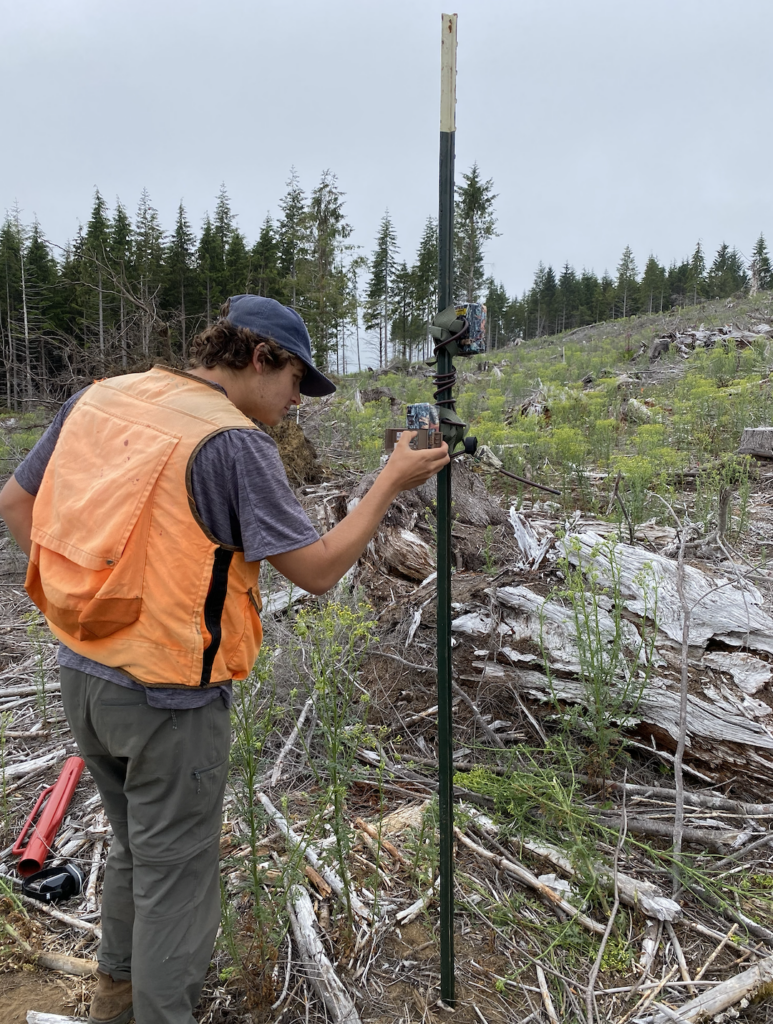Student Research
ONRC has worked with many talented students on their research. Below is some of the recent work done by University of Washington students.
Scotch Broom (Cytisus scoparius) Mitigation on the Olympic Peninsula: A T3 Watershed Experiment Sub-Study
By: Paisley Blume
Read Paisley’s capstone here and check out her poster here.
Synopsis: The increase of Scotch broom (Cytisus scoparius) on the Olympic Peninsula raises significant concerns over its detrimental impacts on forest ecosystems, native plants, and local communities. Its rapid growth and dense thickets outcompete valuable species, reduces biodiversity, alters habitat structures, and impacts soil legacy. This invasive plant also threatens cultural and economic well-being by reducing the resources for native vegetation that are integral to Indigenous practices as well as primary and secondary forest products.
This Scotch broom mitigation sub-study design includes 16-acres of treated area across 4 watersheds located within the T3 Watershed Experiment, a 20,000-acre experiment in the Olympic Experimental State Forest (OESF). It was produced through the assembly of the Scotch Broom Sub-Learning Group via the Invasive Species Learning Group. The Scotch broom Sub-Learning Group played a critical role in defining research objectives, sharing knowledge, and designing mitigation treatments to test their effectiveness in reducing Scotch broom in the T3 Watershed.
Understanding Edge Effects on Competition Dynamics for Pseudotsuga menziesii in the Sappho Long-term Ecosystem Productivity Study
By: Josh Kim
Read Josh’s capstone here.
Synopsis: The effect of forest edges (denoted “edge effects”) are wide ranging in cause, including microclimate effect, ecophysiology, and competition dynamics. Altered competition dynamics on the edge would have significant ecological and silvicultural implications, however, they have not been thoroughly explored. Here, I explored competition dynamics across forest edge and interior conditions for Pseudotsuga menziesii ((Mirb) Franco) in a clear-cut, regenerating, managed forest in the Sappho Long-Term Ecosystem Productivity Study on the Olympic Peninsula in Washington State. I compared field and LiDAR-derived metrics like height to DBH (H/DBH) and canopy area (H/CA) ratios, as proxy measures for competition, across edge conditions, along with analysis of spatial effects of distance to edge (DTE) on competition metrics and live crown ratio (LCR) to understand edge effects.
 Alnus rubra Covers Effect on Soil Litter Across Multiple Scales
Alnus rubra Covers Effect on Soil Litter Across Multiple Scales
By: Drew Blackwell
Check out Drew’s poster here.
In the face of climate change, forest managers are becoming more concerned about how best to manage forests not only for productivity, and/or conservation but also for carbon sequestration. As management needs shift, managers require new methods and tools with which to manage their forests for carbon sequestration and productivity. Red alder has potential to be commercially productive, rapidly accumulates biomass C, contributes to soil productivity through N2 fixation, and can increase mineral soil organic matter of 500 to 1200 kg ha-1 yr-1. Measuring change in mineral soil C is difficult because of high variability and sample processing expenses. Using litter layer sampling may make assessment more practical. This study uses soil samples and red alder data collected at a long-term ecosystem productivity study in Sappho, WA to assess the relationship and influence red alder may have on soil development.
 Ecosystem Responses to Swiss Needle Cast, Thinning, and Interplanting in Coastal Oregon Douglas-fir Forests
Ecosystem Responses to Swiss Needle Cast, Thinning, and Interplanting in Coastal Oregon Douglas-fir Forests
By: Delaney Skiles
Read Delaney’s capstone here.
Synopsis: In 1910, Swiss needle cast (SNC) was first spotted in North America in a coastal forest in Oregon. This foliar disease caused by the ascomycete fungus Phaeocryptopus gaeumannii affects Douglas-fir trees. It’s often found in forested areas with wet and foggy springs, early summers, and mild winters. It causes premature needle loss by clogging needle stomates, resulting in thin crowns and yellowing foliage. As climate change continues, coastal forests will have wetter, warmer seasons and milder winters, creating the perfect conditions for SNC. This could further reduce timber yields and quality, negatively affecting revenue. It is imperative that we understand the effects of this pathogen’s influence on ecosystems as a whole as we improve our knowledge of effective forest and timber management. In this capstone I will examine the effects of SNC, thinning, and interplanting on understory abundance, diversity, and ungulate browse.
 Utilizing LiDAR to Explore the Effects of Windthrow on Pacific Northwest Forests
Utilizing LiDAR to Explore the Effects of Windthrow on Pacific Northwest Forests
By: Anna Thario
Read Anna’s capstone here.
Synopsis: Windthrow, the uprooting of trees due to strong winds, significantly impacts forest dynamics by creating canopy gaps, promoting biodiversity, and influencing soil and nutrient cycles. This ecological process, while beneficial for forest succession, poses challenges for managed forests aimed at timber production due to potential yield loss. This study investigates the effects of windthrow on forest structure and composition in the Pacific Northwest, specifically within the Long-Term Ecosystem Productivity (LTEP) study site in Sappho, Washington. Utilizing LiDAR, I assessed the extent and impact of windthrow across areas with three different silviculture treatments. Despite challenges with data size for the LiDAR-based analysis, the data exploration elucidated that windthrow likely did spur successional patterns in the affected plots.
Using a LiDAR-based model to predict basal area increment
By: Kyle Yasui
Read Kyle’s capstone here.
Synopsis: Predicting forest growth patterns is an invaluable tool when managing forests for timber production, carbon sequestration, and rare species conservation. Basal area increment (BAI) is often utilized as a method of quantifying these growth patterns. Although ground measured data is still an important aspect of calculating this metric, the potential for remote sensing, particularly LiDAR, to be used in modeling BAI is enormous. In this study, we used established tree plots that have been measured on the ground over the span of 19 years to train a LiDAR-based model to predict BAI.
Comparing LiDAR techniques for use in identifying red alder in the Sappho Long-term Ecosystem Productivity Experiment
By: Jaren Hutchings
Read Jaren’s capstone here
Synopsis: The development of Light Detection and Ranging (LiDAR) technology has opened new areas of exploration in a variety of fields. In forestry, LiDAR shows promise to solve a continuous struggle in forestry data collection: determining which species are present in a stand. In this study, we focused on identifying red alder in primarily coniferous stands in the Long-Term Ecosystem Productivity (LTEP) experiment near Sappho, WA. We compared the results of a previous analysis, which determined the efficacy of publicly available aerially-flown LiDAR scans of the area.
Regenerating Western red cedar under ungulate browsing pressure in the Olympic Peninsula: An ethnoforestry approach
By: Rose Cornwell
Read Rose’s capstone here.
Synopsis: The increase in deer and elk populations across the United States raises concerns over impacts on forest ecosystems and communities as well as individual plant species. Western red cedar is highly susceptible to ungulate browse compared to other conifer species, resulting in structural damage and low survivorship of seedlings. Abundance of this ecologically, culturally, and economically valuable species has decreased in recent decades in part due to difficulty associated with re-establishment. Challenges with regeneration come with the economic burden of browse prevention, and the uncertainty of success for organizations, communities, and individuals interested in growing this tree species. This management plan presents a 33.31 acre cedar browse substudy nestled within the T3 Watershed Experiment – a 20,000 acre experiment taking place in the Olympic Experimental State Forest (OESF).
Accuracy of RS-FRIS in the Sappho Long Term Ecosystem Productivity Experiment
By: Sarah Crumrine
Read Sarah’s capstone here.
Synopsis: The Washington Department of Natural Resources (DNR) publishes statewide predictions of various forest characteristics—diameter, density, height, age, species composition—in publicly-available spatial datasets called RS-FRIS (Remote Sensing Forest Resource Inventory System). Sarah investigates how forest metrics reported by RS-FRIS compared to ground data in the Long-Term Ecosystem Productivity (LTEP) experiment in Sappho, WA. The purpose of this comparison is to evaluate if the RS-FRIS data can make reasonably accurate predictions of treatments in the LTEP experiment site and the feasibility of using this in other research sites with novel silviculture treatments.
Habitat predictors of bird occupancy in managed forests in the Pacific Northwest Coastal Region
By: Shawree Zhang
Read Shawree’s capstone here.
Synopsis: Complex early-seral habitat, a successional stage between a stand-replacing disturbance and tree canopy closure, is an important part of the forest life cycle in the Pacific Northwest characterized by high biodiversity and a heterogenous structure. The Type 3 Watershed Experiment being conducted in the Olympic Experimental State Forest includes treatment that mimics natural regeneration in timber stands after a severe windstorm, the goal being to explore the practicality of promoting early-seral habitat while continuing to produce timber. Two indicators are used to examine the ecological effects of this treatment: habitat conditions (e.g., vegetation structure and composition) and avian response as measured by passive acoustic monitoring. This capstone provides an analysis of the pre-harvest habitat conditions and occupancy of 10 bird species at 32 sites.

Conifer Species Identification in High-Density Drone LiDAR
By: Will Browne
Read Will’s capstone here.
Synopsis: Remote sensing techniques have been used to assess forests for decades. A newly emerging approach is through the use of drone LiDAR, which results in dense point clouds that can be used to monitor forest resources more accurately than ever before. In this capstone, Will used these data to distinguish between two common conifer species: Douglas-fir and Western hemlock. This technique can be expanded to include additional species to assist with long-term and large-scale monitoring of forests.
Using LiDAR to Identify Red Alders in the Sappho Long-Term Ecosystem Productivity Experiment
By: Ally Kruper
Read Ally’s capstone here.
Synopsis: A fundamental question of forestry is that of composition: which species are present, and which are not. However, traditional forest inventories can be both time consuming and costly. In this study, we combined remote sensing light detection and ranging (LiDAR) data with field data from the Long-Term Ecosystem Productivity experiment located near Sappho, Washington. We utilized this combination to both increase the accuracy of our GIS data and to discriminate between red alder and other tree species. To achieve this, we created LiDAR canopy height models, manually matched tree canopies with tree stem maps based on field data. We then created a classification model based on LiDAR point returns that was able to successfully discriminate between red alder and other species.
Ally also turned her capstone project into a published paper. Check out the full paper published in Remote Sensing here.

Olympic Natural Resources Center Forest Management Plan
By: Brian D. Chan
Read Brian’s Master’s of Forest Resources Capstone here.
Synopsis: The University of Washington Olympic Natural Resources Center (ONRC) is a 33-acre forested property in Forks, Washington on the Olympic Peninsula. This project details a proposed forest management plan for ONRC forests that uses methods from the Type 3 Watershed Experiment and includes three management alternatives.
Sword ferns in the Pacific Northwest: A greenhouse experiment and field investigation.
By: Chloe May
Read Chloe’s capstone here.
Synopsis: Sword ferns are ecologically and culturally important to Pacific Northwest ecosystems. The growth patterns, physiology, and spore reproduction are not well studied. In addition, localized die offs of this species in Western Washington is not well understood. This capstone analyzed sword fern browse data from a long-term ecosystem productivity study in the Siuslaw National Forest and paired this with a greenhouse experiment to better understand the growth and survival of this species.








